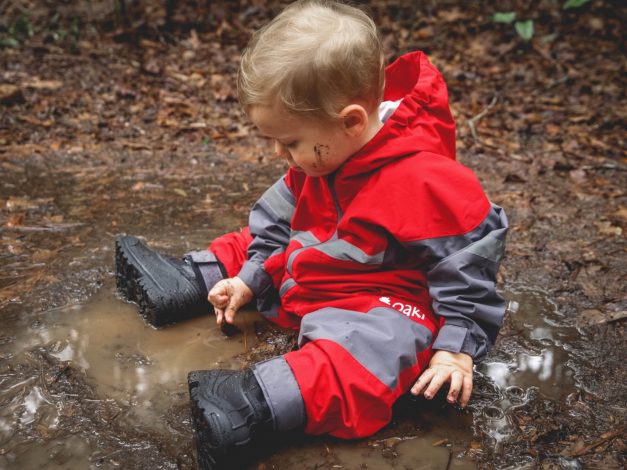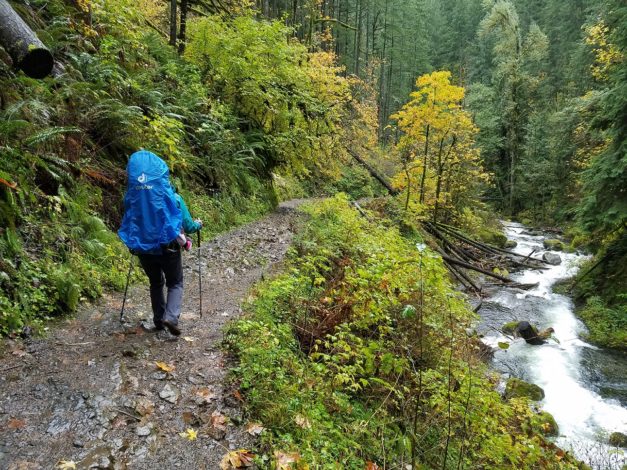5 Gear Essentials for Hiking in the Rain with Kids
Just because you're outside hiking in the rain doesn’t mean you have to be soaked to the bones. Make sure you are covering yourself and your kiddo from head to toe in waterproof gear. With careful planning and the right accessories to keep you warm and dry, you and your kiddo can enjoy your hikes and play in the rain longer.
1. Go beyond the raincoat
When dressing your child, a full rain suit is a great option. There are no gaps in the material for water to sneak in. Oaki makes amazing rain suits and gear! My daughter has spent hours in the pouring rain and gone swimming in some epic puddles in hers. Afterward, I'm always shocked when I peel it off and she is completely dry underneath. If the suit is a challenge because of potty training or an older child who wants a little more independence, a long rain coat and pants works great.
Pro tip: Size up in rainsuits if your little one will be in a carrier because it tends to pull the legs of the suit up and can leave gaps above their boots.

2. Take care of yourself
If your child is warm and dry but you are drenched, the hike is going to be miserable for you. Get yourself a waterproof jacket and pants to keep yourself dry -- especially if you want to join in some puddle splashing too! Also consider how you can stay dry if you will be wearing your kiddo.
3. Don’t forget your feet
Rain boots that are tall enough to be covered fully by the pants legs are a must. Make sure they are fully waterproof and insulated if you live where it is cold. Fortunately, most kids love rain boots, and they come in all sorts of happy patterns and colors. You will likely have more trouble getting your kids out of their rain boots than into them. Get yourself some waterproof boots too or minimally consider spraying your old hiking boots with waterproofing spray.
4. Waterproof your gear
If you're carrying a pack with all your hiking essentials inside, get a pack cover to waterproof your cargo. And if you have a frame-style carrier like a Deuter, they make great rain pack covers to provide even more protection. If you are out in the rain with a stroller, look into one of the rain covers for the stroller that zip on and keep your kiddo warm and dry inside.

5. Warming layers and post-hike dry clothes
Make sure to wear warm, wicking base layers to keep you cozy underneath. Wool clothing (like Luv Mother) is a great option - as it stays warm when wet and wicks away the moisture. Rain coats are often just shells so make sure to have solid layers underneath that you won't sweat in but will hold in the heat. Bring a hat to slip on under a hood and a couple pairs of gloves since those will inevitably get soaked.
Pro tip: Have warm, soft, cozy clothes waiting in the car to slip into after the hike if you do end up a little cold and soggy. Having my daughter’s favorite pair of fleece or wool pants waiting in the warm car always works well as a motivator to push to the end of a rainy hike. (Hot cocoa waiting in the car is also a lovely treat!)
Bonus tip: Hike it Baby offers discounts to members on many of these brands. Check out our Community Discounts page for current deals!
Read more
- Getting outside - even in the rain
- What to wear: Hiking in the rain and winter
- Winter layering options for mothers
- Kids' Perspective: 5 Things kids like about hiking in the rain and cold
What are your go-to gear items or tips for hiking in the rain and cold? Leave a comment below!
ABOUT OUTGROWN
OutGrown is a 501(c)(3) nonprofit that works to create a world where everyone can enjoy the physical and mental benefits of spending time outside. We are focused on creating opportunities and removing barriers to access so families with babies and young children can take their first steps outside. We believe all families have the right to connect with nature, benefit from spending time outdoors and be inspired to a lifelong love of nature. Since its grassroots inception in 2013, OutGrown is a growing community of 280,000 families and over 300 volunteer Branch Ambassadors. More information on all of our programs can be found at WeAreOutGrown.org
EDITORS NOTE:
We hope you enjoyed reading this article from OutGrown. We’re working hard to provide our community with content and resources that inform, inspire, and entertain you.
But content is not free. It’s built on the hard work and dedication of writers, editors, and volunteers. We make an investment in developing premium content to make it easier for families with young children to connect with nature and each other. We do not ask this lightly, but if you can, please make a contribution and help us extend our reach.
Related Content




Comments